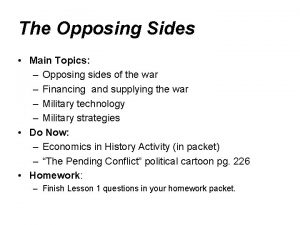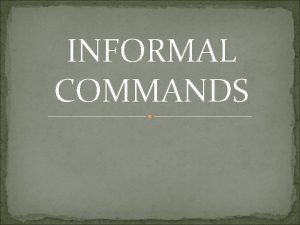Chapter 16 1 The Two Sides Define o














- Slides: 14

Chapter 16. 1 The Two Sides

Define: o o o Border States: States that allowed slavery, had ties to both the North and the South, and were of strategic location. Export: Selling, or shipping products to other countries. Blockade: Military strategy closing Southern ports using Northern warships to block shipping traffic.

Border States o 1. Name the four border states. o o Delaware, Missouri, Maryland, and Kentucky. 2. Why were they vital to the Union? o They held strategic importance because of their location.

Border States o 3. Which was most important and why? o n Maryland – Because of its closeness to Richmond, VA, and most importantly because the Union capitol of Washington DC resides there. Was Lincoln successful at keeping in the Border States? o Yes!

Comparing the North and the South o North's Advantages: Population and Resources. o South's Advantages: Excellent military leadership, strong fighting spirit, and home field advantage, most of the war was fought on their soil.

War Aims o What were the South's reasons for fighting? n o Did it need to invade the Union to win? n o To establish itself as an independent nation. No, just defend itself until the Union gave up. What was the North's reason for the war? n To restore the Union.

Confederate Strategies o Explain the Strategies of the South: n n n They were hoping for aide from France and Britain. Plan was to hold as much territory as possible and hope the North grows tired. (Defensive War) Attack Washington DC

Union Strategies o What were the 3 main strategies for winning the war? n n 1. Blockade southern ports to prevent supplies from reaching the Confederacy. 2. Gain control of the Mississippi River and split the Confederacy in two. 3. Capture Richmond, VA the confederate capital Known as the “ANACONDA PLAN” – Gen. Scott.

Americans Fighting Americans o What were some different reason for fighting? n Patriotism or loyalty to ones cause. Others thought they would be considered cowards if they did not fight, and some others just yearned for excitement.

Americans Fighting Americans o With some of the soldiers being younger than 18, and some as young as 14. How would they be able to join the Army? n o Which group of people was not allowed to fight in either sides military at first? Why? n o Ran away from home and lied about their age. African Americans, because the leaders worried that the white soldiers may not accept them. Did either side change their policy? n Yes, the North.

The Soldiers o o What Percent of troops were farmers? Northern Troops n o Southern Troops n o About 50% >60% How long was the original enlistment period for the North? n 90 Days.

The Soldiers o How many men fought on each side during the war? n n North: 2, 100, 000 South: 900, 000

Life of a Soldier o Explain the Life of a soldier: n n n Suffered Terrible hardships, while facing new challenges. Boredom, discomfort, sickness, fear, and horror are some of the hardships faced by soldiers. Camp life: Sang songs, told stories, wrote letters home, and played games. Although a lot of the time the life consisted of drills, bad food, marches, and rain.

Reality of War o What were some of the new realizations of this new war? n n n New rifles with greater accuracy brought on terrible losses. Overcrowded medical facilities overwhelmed with thousands of casualties. Sometimes wounded would lay in the field for 24 hours before being attended too. 1 out of every 11 Union soldiers deserted. 1 out of every 8 Confederate soldiers deserted. o They fled because of fear, hunger, and sickness.
 Angle pair relationships
Angle pair relationships Two sides of the cold war
Two sides of the cold war Stage positions
Stage positions A solid object with two identical ends and flat sides
A solid object with two identical ends and flat sides Kite number of congruent sides
Kite number of congruent sides Quadrilateral
Quadrilateral Quadrilateral family tree
Quadrilateral family tree What are the two sides of fire service discipline?
What are the two sides of fire service discipline? If two sides of a triangle are congruent then
If two sides of a triangle are congruent then Shape that has 2 pairs of parallel sides
Shape that has 2 pairs of parallel sides Stage right
Stage right Multi step equations with variables on both sides
Multi step equations with variables on both sides Transverse stage
Transverse stage Similar images
Similar images Each coin has two sides
Each coin has two sides



























